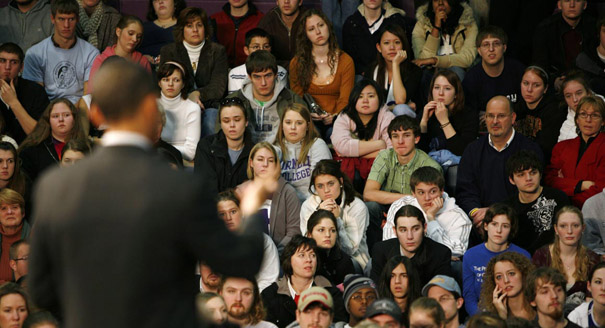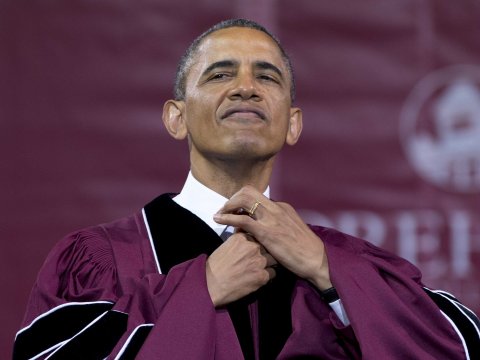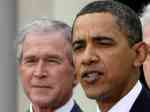College debt and a sputtering economy are hurting Millennials and they’re starting to notice.
Videos by Rare
According to a recent Harvard University survey, 57 percent of Millennials believe student debt is a “major problem.”
Only 41 percent of them think President Obama is doing a good job.
There are multiple contributing factors to these numbers. Among them, rising unemployment for the Millennial age bracket, decrease in annual income, more living at home with parents and high delinquency on loan payments. The average college debt has also increased by 21 percent for public colleges and universities.
According to the latest Bureau of Labor Statistics, the unemployment rate for 16-to-24-year-olds sits at 14.4 percent, while income for 25-To-34-year-olds fell by $1,684 as early as 2012. 13.9 percent of the latter age group were living with their parents as of 2013, more than a 700,000 increase since President Obama was sworn in in 2008.
These statistics have clearly contributed to Millennial discontent.
RNC Spokesman Raffi Williams explained the effects of the current economy on college degrees, saying, “Due to the Obama economy, college diplomas have depreciated in value while college costs have increased.”
He added, that the administration, “Instead of working to promote legislation that will increase youth employment, and make it easier for young people to pay back student loans the President” is instead “blowing hot air that leaves young Americans out to dry.”
The problems that began in 1971 are being perpetuated today.
In 1971, the Griggs v. Duke Power decision unanimously inscribed “disparate impact” into law, which dictates that certain employment practices that are discriminatory — intentionally or not — and that adversely affect minority groups, should be outlawed. The court explained: “What Congress has commanded is that any tests used must measure the person for the job and not the person in the abstract.” This is a law that seems good on its face, but it creates more problems that in solves.
Necessarily, after “disparate impact,” we needed to find a standard by which to measure someone’s job ability or potential. That measure became the college degree. Once this precedent was established, college attendance became a formality. Today, if one shows up to an interview and says they didn’t attend college, employers wonder what’s wrong with them.
“From 1982 to 2007,” Deseret News reported, “the national average increase [in tuition] at America’s universities was 400 percent.” As college attendance rose, tuition costs and government subsidies rose rapidly. Here is a rundown of attendance statistics in the last decade:
Between 2000 and 2010, the number of 18-24-year-olds went from 27.3 million to 30.7 million, an increase of 12 percent. During that time, the percentage of 18-24-year-olds enrolled in college rose from 35 percent in 2000 to 41 percent in 2010. In addition to enrollment in accredited 2-year colleges, 4-year colleges, and universities, about 539,000 students attended non-degree-granting, Title IV eligible, postsecondary institutions in fall 2009.
Compare the numbers: 1,427,000 16-24-year-olds enrolled in college 1970, 12,587,000 18-24-year-olds in 2010—and neither of these statistics tells us about graduation rates for those pursuing a bachelor’s degree and attaining it within six years of starting. As of 2011, that rate is 59 percent.
While higher education has ballooned, so have the problems; inefficiency, administration, and health insurance are cited in the Deseret News report as three contributing factors to high cost.
All three of these, however, are tied primarily to bureaucratic involvement.
The Fed, which now stands in as the higher education’s main creditor, doles out artificially low-interest loans to millions of young adults. Young people are now working for low wages for less hours, as Obamacare looms, to pay off the accrued college debt that may or may not have resulted in a degree.
If they were successful in graduating, nine times out of ten it’s just seen by potential employers as another degree.
The actual knowledge or skills acquired is also illusive. A study from the Collegiate Learning Assessment found that “45 percent of students tested after their second year in college showed no improvement in their development of ‘higher-order cognitive skills.’”
College is about learning; if that’s not happening then it seems that higher education is just another casualty of the welfare state, where people become beholden to government sponsored programs and use them simply because they can or are told to–not because it is in their best interest.
As government increases in size, the quality of government decreases, particularly in areas like efficiency, administration, health care—as we’ve seen firsthand with Obamacare—and our overall freedom.
And all the while, costs increase.
The more government has become involved in education, the more it’s led to this particularly odious form of debt bondage — putting the squeeze on Millennials more than ever.




